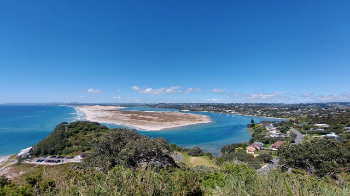
MANGAWHAI'S NO.1 NEWSPAPER
|
|
|
Rising sea level study a warning to coastal communitiesJULIA WADE 09 May, 2022
Presented by NewsHub on May 1, the newly-released research conducted by NZ SeaRise combined for the first time New Zealand’s minute ‘vertical land movement’ (VLM) with rising sea levels. The startling results – which even shocked researchers –showed the country’s shoreline water levels will increase two to three times more than the global average, with the impact noticeable in only a few decades instead of the predicted 40-50 years. Lead scientists, professor Tim Naish, and associate professor Richard Levy have been working on the climate change study for five years including drilling ice-cores and sediment in Antarctica to glean climate information from millions of years ago, and have also created a detailed map allowing all Kiwis to view the effects on their own community. Coloured dots show VLM for every 2km of New Zealand’s 15,000km coastline, with blue spots pinpointing where land is subsiding at a rate between -3 to -5mm per year. Mangawhai’s harbour and surrounding beaches including Te Arai, is one of the most blue-speckled locations in Northland along with Tinopai, Whangaruru Bay and Tutukaka. Information on the site states that areas showing higher subsidence will have an accelerated impact of rising sea levels and potentially double the annual sea level rise, affecting coastal homeowners, businesses and the lives of many who reside close to the shoreline. The question of property devaluation, resale value and insurance rights are yet to be answered, although Prime Minister Jacinda Arden has stated work is currently underway with local government and private insurers to share the inevitable costs. Northland Regional Council (NRC) manager for climate change, Tom FitzGerald, says the new sea-level rise projections ‘are a really important piece of the puzzle’ and a critical tool to help Northland adapt to the growing effects of climate change. “At first glance, the effects vary across the region, with some coastal areas seeing an increase in projected sea-level rise while others could experience a decrease, and there are also some areas in our region that are not yet captured in these new projections,” he says. “We’re going to do further detailed analysis on what this means for our coastal areas, especially in relation to our existing coastal hazard maps and infrastructure such as our roading network, which is particularly vulnerable.” NRC’s current coastal hazard maps, available on the council’s website, were published last year, and ‘in time’ will be adjusted to reflect the new information. The council is also part of Climate Adaptation Te Tai Tokerau and the Northland Infrastructure Climate Change Project, ‘which are assessing and preparing for what climate change throws at us’. Information is critical FitzGerald says, ‘the more the better’ to help council understand the risks and work required to foster resilience of communities and ecosystems, ‘especially those close to the coast’. “What this new sea rising information reinforces is that the effects of climate change vary depending on local factors, and it is coming at us more quickly than many people realise,” he says. “We can’t just adapt once and think we’ve done the work – we must continue to adapt as our communities and environment changes, in order to be resilient and thrive.” n Due to new town development Mangawhai Central being included in the coastline 'blue dot' area, the Focus contacted the company for their response or concerns regarding the research, however no reply was received at time of print. “… the effects of climate change vary depending on local factors, and it is coming at us more quickly than many people realise.” – Tom FitzGerald, NRC
New research into rising sea levels and sinking land mass is a warning to coastal areas like Mangawhai, and experts say it’s important to prepare and plan for the future sooner rather than later. PHOTO/JULIA WADE Council has identified Mangawhai as an ‘exposed location’. The effects of climate change and coastal hazard risk management will be a part of the 2021-2031 Long Term Plan. PHOTO/GRANT CROWE |

 Aotearoa’s clash of shifting lands with the worlds rising sea waters causing a fast-forwarding of climate change effects, has sent shockwaves through the country recently following a cutting-edge study containing a solemn warning, especially for coastal communities like Mangawhai.
Aotearoa’s clash of shifting lands with the worlds rising sea waters causing a fast-forwarding of climate change effects, has sent shockwaves through the country recently following a cutting-edge study containing a solemn warning, especially for coastal communities like Mangawhai. Council commit $1.5m over 10 years for Climate Change Work Programme
Council commit $1.5m over 10 years for Climate Change Work Programme
